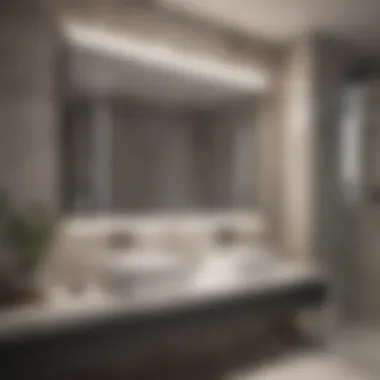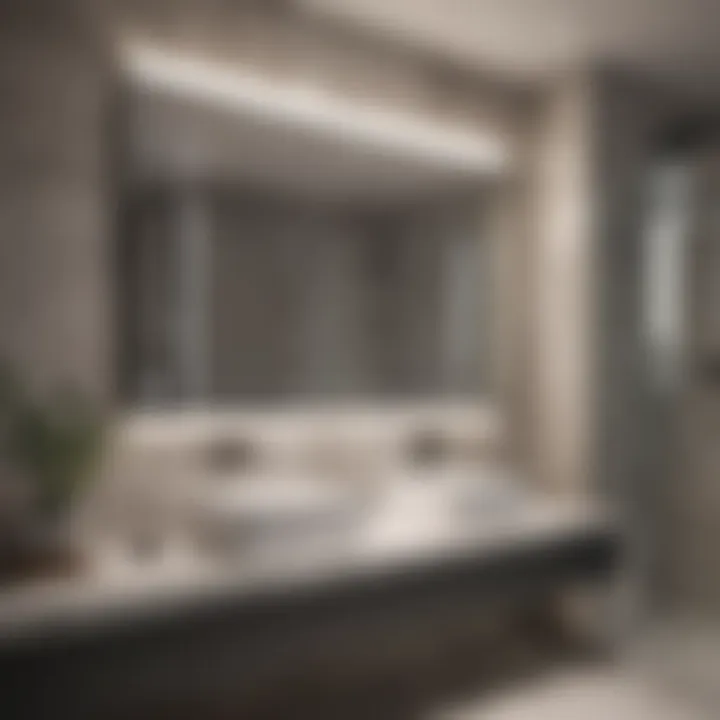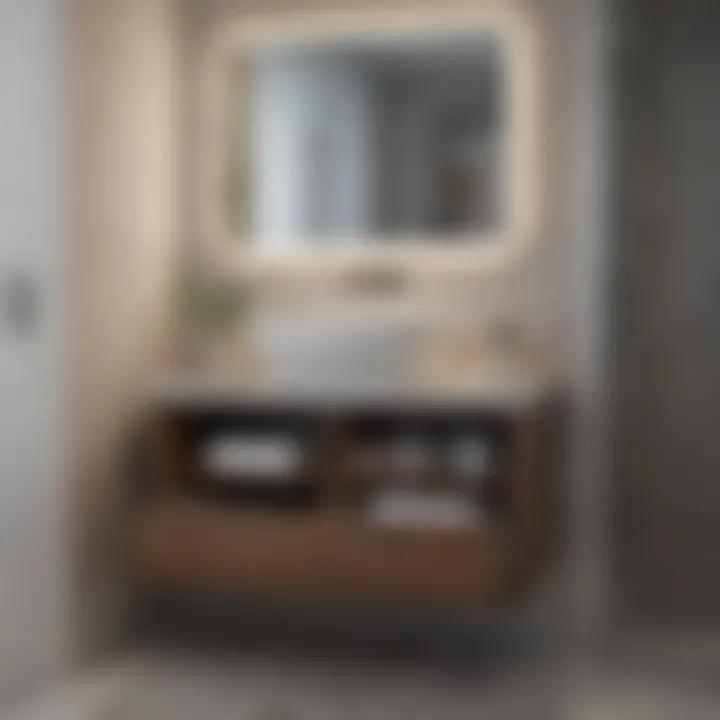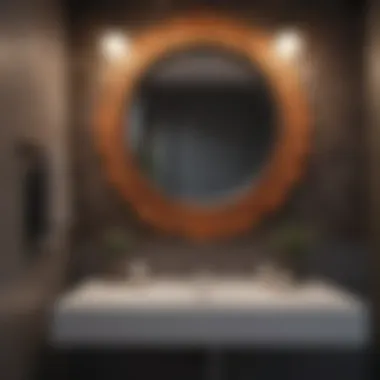Transforming Small Bathrooms: Strategic Upgrade Tips


Intro
Small bathrooms often present a unique set of challenges, converting them into an appealing and functional space requires thoughtful planning and strategic upgrades. This article delves into effective strategies to enhance the aesthetics and functionality of modest bathroom spaces. By focusing on design principles, material selection, and innovative storage solutions, homeowners can effectively transform their small bathrooms into stylish retreats. Mindfully navigating these upgrades not only adds value to a home but significantly improves the overall experience in these intimate spaces.
Trending Styles
Modern Minimalism
Modern minimalism is a dominant trend in small bathroom design. This style prioritizes clean lines, open spaces, and a restrained color palette. To achieve this look, consider using wall-mounted fixtures, which create the illusion of more space. Opting for a floating vanity frees up the floor area while providing essential storage.
Incorporating glass shower doors instead of bulky curtains also enhances the airy feel of the space. Choose essential accessories that blend seamlessly with the design. Decluttering is key in a minimalist approach. Keep only necessary items visible, investing in discreet storage solutions to hide away less attractive bathroom essentials.
Cozy Rustic
Alternatively, the cozy rustic aesthetic cultivates warmth and comfort. This style often embraces natural materials like wood and stone. Consider using reclaimed wood for shelving or a vanity to invoke a sense of charm. Accent pieces, such as woven baskets or vintage ceramics, can serve practical purposes while enhancing the room’s character.
In this style, choosing soft lighting fixtures, like sconces or pendant lights, can create a welcoming ambiance. Earthy color tones, combined with plants, can also bring a touch of nature into the small space, making it feel more vibrant and relaxed.
Color Palettes
Calming Neutrals
Calming neutrals tend to work exceptionally well in small bathrooms. Shades like soft grays, whites, and beiges create a cohesive background that makes the space feel larger. These tones can easily complement various styles, whether minimalist or rustic. When using neutrals, consider layering various textures to add depth, such as matte paint finishes paired with glossy tiles.
Bold Accents
To infuse character into a neutral backdrop, bold accents can be strategically added. This approach can be through bright accessories or feature walls. A single wall painted in a deep, vibrant shade can serve as a focal point without overwhelming the space. Consider using bold-colored towels or decorative items to maintain the bathroom's lively spirit.
Preamble to Small Bathroom Upgrades
Small bathrooms often present unique challenges that require innovative solutions. It is essential to recognize the potential of these compact spaces as functional and appealing areas in a home. Upgrading small bathrooms can significantly enhance their usability and aesthetics, transforming them into pleasant retreats rather than merely utilitarian spaces. This article aims to provide detailed insights into effective strategies for upgrading small bathrooms, emphasizing design principles, space maximization, and the careful selection of materials.
Understanding the Importance of Upgrades
Upgrades in small bathrooms are not just about making a space look nice. They can contribute to improved functionality, increased property value, and greater comfort. A well-designed upgrade can make daily routines smoother, enhance storage capabilities, and ensure more efficient use of space. Homeowners and renters can benefit vastly from understanding that even minor changes can result in immense improvements. For example, the installation of modern fixtures can help save water while maintaining style.
Moreover, these upgrades present an opportunity to incorporate personal styles into a home’s overall design. A thoughtfully upgraded bathroom can reflect the homeowner’s taste while addressing practical needs. When planning these changes, it is important to consider both aesthetic and functional aspects. By doing so, the project can lead to a truly satisfying result.
Defining a Small Bathroom
A small bathroom generally refers to spaces that encompass less than 40 square feet, though definitions may vary based on personal interpretation. Understanding what constitutes a small bathroom is key for homeowners. These spaces may be cramped, but they can still be highly functional and aesthetically pleasing. Think of layouts designed specifically to maximize shower or bath space without sacrificing comfort.
In many homes, small bathrooms often consist of a basic setup: a toilet, sink, and shower or bath combination. This configuration can feel restrictive; however, it allows for creative design solutions. It is vital to get familiar with the dimensions and layout, as this knowledge directly influences potential upgrades. Effective planning entails not only measuring these areas accurately but also identifying the specific needs and preferences of the household.
"The smallest changes can lead to a remarkable transformation when upgrading small bathrooms."
Assessing Your Current Bathroom
Assessing your current bathroom is a critical first step toward any successful upgrade. This stage focuses on understanding your existing space, its functionality, and its limitations. By evaluating your bathroom thoroughly, you can make informed decisions that align with your aspirations and needs. Knowing what works well and what doesn't will guide your choices as you move towards your desired outcome.
Conducting a Space Evaluation
Conducting a space evaluation allows homeowners to understand the dimensions and layout of their small bathroom. Start by measuring the length, width, and height of the room. This data will provide a clear representation of the available space, allowing you to visualize potential design changes.
After measuring, analyze the layout. Pay attention to the locations of essential fixtures such as the toilet, sink, and shower. Evaluate the flow of movement within the space. Ensure that openings such as doors and cabinets do not interfere with each other or create a cramped atmosphere. Take note of how the current layout impacts comfort and usability.
To assist in this process, you may consider using graph paper or design software to create a scaled representation of your bathroom. Sketching it out visually can clarify how changes will affect the workspace and aesthetic. This evaluation is crucial for developing a cohesive plan that optimally utilizes every inch of your small bathroom.
Identifying Existing Limitations
Identifying existing limitations involves examining the obstacles that inhibit the current function or appearance of your bathroom. Common limitations in small bathrooms can include inadequate storage, insufficient lighting, or poorly planned layouts.
Start by scrutinizing storage options. Notice if your bathroom lacks cabinets or shelves that can hold toiletries and linens. Identify areas where you might have underutilized space. For example, consider whether vertical storage could be implemented in a more effective way. Additionally, if clutter is a consistent issue, note potential solutions that could streamline your space.
Next, consider the lighting situation. Does your bathroom feel dark and unwelcoming? Often, small bathrooms benefit from additional lighting options or strategic placement of mirrors to enhance brightness. Evaluate the natural light sources as well; perhaps existing windows are obstructed or undervalued.
Lastly, think about the overall functionality of the space. Are there design flaws that inhibit daily use, such as tight spaces between fixtures? Assessing these limitations serves as a basis for developing an effective upgrade plan that addresses each of them comprehensively.
Design Principles for Small Spaces
In small bathrooms, design principles hold significant strategic value. Effective application of these principles can transform a modest space, making it feel larger and more functional. Understanding and implementing design strategies is essential for enhancing not only aesthetics but also practicality. With spatial constraints, it becomes crucial to maximize every square foot while ensuring visual appeal.
Creating Visual Openness
Creating visual openness is a fundamental design principle for small bathrooms. This involves minimizing visual clutter and enhancing the perception of space. By utilizing light color schemes and reflective surfaces, one can achieve an airy atmosphere. For instance, using one continuous color palette can help reduce visual fragmentation. In addition, mirrors can provide depth and reflect light, effectively doubling the perceived space. Installing large mirrors or mirrored cabinets can be particularly effective, adding functionality while promoting a sense of openness.
Using Color to Enhance Perception


Color choice plays a pivotal role in shaping the perception of space. Lighter colors, such as whites or pastel shades, can create a feeling of expansiveness, making a bathroom seem larger than it is. On the other hand, darker hues may confine and compress the space. It is often beneficial to choose a consistent color palette for walls, tiles, and accessories, which fosters a harmonious look. Accent colors can introduce character but should be used sparingly to prevent overwhelming a small area.
"A room’s color scheme greatly influences its atmosphere and perceived dimensions. Light colors create a more expansive feel, while dark colors can limit space visually."
Lighting Considerations
Effective lighting is another crucial design factor. Natural light should be prioritized when possible; it instantly enlarges any space. Consider sheer window treatments or strategically placed mirrors to maximize daylight. For artificial lighting, a layered lighting approach is often the best solution. Combining ambient lights with task and accent lighting can establish a well-lit environment that meets various needs. Opting for sleek fixtures can prevent overpowering the visual space. Therefore, well-placed fixtures can illuminate all corners without feeling cluttered.
In summary, adhering to these design principles is vital when upgrading a small bathroom. Creating a sense of openness, careful selection of color, and strategic lighting choices can dramatically improve both the aesthetic appeal and functionality of the space.
Maximizing Space in Small Bathrooms
Maximizing space in small bathrooms is essential for creating an environment that feels more expansive and functional. Small bathrooms often suffer from poor layout, which can lead to clutter and a feeling of confinement. By employing strategic methods to maximize space, homeowners can achieve an arrangement that promotes efficiency and comfort while also enhancing the overall aesthetic.
Storage Solutions that Work
Utilizing Vertical Space
Utilizing vertical space is a fundamental aspect of effective bathroom design. It involves making use of wall areas for storage instead of relying solely on floor space. This approach is particularly valuable in small bathrooms where every inch counts. Adding shelves, cabinets, and hooks above the sink or toilet can transform unused wall areas into functional storage zones.
The key characteristic of this method is its ability to make items easily accessible while keeping the floor area clear. This not only helps with organization but also creates the impression of a larger space. One unique feature of vertical storage is that it can often be customized to fit one’s needs, allowing for tailored solutions that resonate with individual tastes.
However, the advantages of vertical space utilization must be weighed against some considerations. Overloading vertical units can create a cramped feeling or make it difficult to retrieve items. Carefully planning the placement and ensuring that the shelves or racks do not feel cluttered is crucial for maintaining a balanced look in the bathroom.
Employing Multi-Functional Furniture
Employing multi-functional furniture is another effective strategy in small bathroom upgrades. This involves selecting items that serve more than one purpose, thus saving valuable floor space. For instance, choosing a vanity with built-in storage or a stool that doubles as a storage unit can significantly enhance functionality without occupying extra space.
The key characteristic of multi-functional furniture is versatility. These pieces can adapt to various storage needs and change as requirements evolve. This adaptability makes them a popular choice for small bathrooms where flexibility is paramount.
A unique feature of this approach is the ability to maintain a clean and organized space with minimal effort. Disadvantages may include a higher upfront cost for quality multi-functional pieces, but the long-term benefits often outweigh this initial investment.
Floor Plan Arrangements
Floor plan arrangements play a significant role in how effectively a small bathroom uses the available space. Considering the flow of movement and the relationship between fixtures can drastically improve both usability and the overall aesthetic. Optimal arrangements should prioritize ease of access to key areas while keeping visual clutter to a minimum.
Several strategies can be utilized in this area, such as placing the vanity opposite the shower to create a balanced look. Using a corner shower can also enhance the overall space efficiency. Furthermore, maintaining a logical arrangement can simplify cleaning and impact daily routines positively.
Choosing Fixtures and Fittings
Selecting the right fixtures and fittings is a pivotal aspect of upgrading your small bathroom. Fixtures such as vanities, showers, and sinks significantly affect both functionality and aesthetics within the limited space. Choosing wisely can enhance usability while also improving the visual appeal. It's essential to consider various factors, such as space constraints, design preferences, and matching styles to create a harmonious environment.
Selecting the Right Vanity
A vanity serves as a focal point in a bathroom. It not only holds the sink but also offers essential storage. When selecting a vanity for a small bathroom, size is critical. A wall-mounted or floating vanity can save space and create an impression of more room.
Consider materials as well; wooden vanities provide warmth, while metal or glass options can add a modern touch. The number of drawers or shelves matters too. A well-organized vanity can reduce clutter, making small bathrooms feel more spacious.
A well-chosen vanity can maximize the functional area, ensuring all necessities are within reach without overcrowding.
Furthermore, think about the color and finish. Lighter colors can make the space feel larger, while darker hues can offer depth. Ultimately, the vanity should reflect your personal style and contain practical storage solutions suited for daily use.
Shower vs. Bath: Evaluating Options
The decision between installing a shower or a bath tub depends on lifestyle and available space. Showers typically take up less room, allowing for better flow within the bathroom. A corner shower can be efficient, keeping the area open. Multiple showerhead options can elevate the experience, even in small spaces.
On the other hand, many homeowners find value in having a bath tub. It is important to consider whether the bathtub is mainly for relaxation or if it will also be used for bathing children or pets. Compact-sized baths or soaking tubs can fit nicely in smaller bathrooms without overwhelming the layout.
Consider the plumbing layout when deciding. Sometimes, retrofitting existing plumbing is expensive. In contrast, a shower may need less adjustment, saving time and cost.
Faucets and Accessories
Faucets and accessories are the finishing touches that can accentuate the overall design of the bathroom. Selecting the right faucet is essential to match the style of your vanity and sink.
Opt for finishes like chrome, brushed nickel, or matte black, depending on your chosen design scheme. A single-handle faucet can save space and make operation simpler, particularly in tight areas.
Accessories such as towel racks, soap dispensers, and mirror frames should coordinate with the overall style too. Aim for a balanced aesthetic: minimalist accessories may work well in contemporary designs, while ornate options may suit traditional styles better.
Optimal Materials for Small Bathrooms
Choosing the right materials for small bathrooms involves more than just aesthetics. Materials affect durability, functionality, and even the overall atmosphere of the space. In smaller areas where space is limited, each element has to be strategic to create a cohesive design. The right materials can enhance usability, ease maintenance, and contribute to a pleasing visual appearance.
Selecting Tiles for Aesthetic and Function
Tiles are one of the most significant elements in a bathroom upgrade. They not only serve practical purposes but also have a visual impact. When it comes to choosing tiles, consider both functionality and design.
Functionality:


- Water Resistance: Since bathrooms are exposed to moisture, selecting tiles that are water-resistant is crucial. Porcelain and ceramic tiles are popular options for their ability to resist water and stains.
- Slip Resistance: Safety is a priority. Choose tiles with a textured surface for floors to minimize the risk of slipping when wet.
- Maintenance: Opt for tiles that are easy to clean. Larger tiles make for fewer grout lines, which can attract dirt and require more upkeep.
Aesthetic Appeal:
- Size and Layout: Larger tiles can create an illusion of space, making the bathroom feel more open. Conversely, smaller tiles work well in intricate patterns, adding character.
- Color and Patterns: Lighter colors help reflect light, enhancing the perception of space. However, darker shades can add depth. Mix and match patterns for a personalized touch but keep balance in mind.
Choosing Countertop Materials
Countertops in a small bathroom not only provide space but also influence the overall style of the room. Selecting the right material is vital for functionality and aesthetics.
Durability:
- Granite & Quartz: These materials are highly durable and resistant to scratches and stains, making them ideal for bathroom use. They also come in various colors and patterns.
- Laminate: While not as durable as stone, laminate can be a cost-effective option. It is easy to maintain but might not withstand heat or impact as well as stone.
Aesthetic Choices:
- Finishes: A glossy finish can create a modern look, while a matte finish may offer warmth and rustic appeal. Choose based on the theme of your bathroom.
- Edge Profiles: The edges of the countertop can also affect the look. Consider the profile carefully to match with the overall design. Simple edges work well in minimalist spaces.
"Choosing the right materials not only improves functionality but enhances the overall ambiance of the bathroom."
In summary, optimal materials in small bathrooms are key components for effective designs. They combine style with practicality, creating spaces that are easy to maintain and visually appealing.
Incorporating Technology
In today’s fast-paced world, technology significantly shapes how we interact with our living spaces. When it comes to small bathrooms, integrating modern technology can transform this room from a purely functional space into a smarter, more efficient haven. The advantages of incorporating technology in small bathrooms extend beyond aesthetics. They offer convenience, energy efficiency, and innovative functionalities that can enhance daily tasks and overall comfort.
Smart Bathroom Innovations
Smart bathroom innovations are an excellent way to boost both functionality and convenience. These devices offer intuitive features that align with our daily routines. For example, smart mirrors equipped with LED lighting can enhance visibility while also displaying useful information like weather updates or calendar appointments. Such mirrors can be particularly beneficial in compact spaces where users desire utility without clutter.
Another notable innovation is touchless faucets. By minimizing contact, these faucets promote hygiene while conserving water. They are ideal for small bathrooms where every inch counts, allowing for cleaner surfaces and less mess. Furthermore, voice-activated technology can control shower settings, lighting, and even music. The integration of these smart devices can create a more enjoyable experience.
Energy Efficiency and Sustainability
The push for sustainability is ever-present in today’s home improvement trends. Small bathrooms can greatly benefit from energy-efficient technologies. Features such as low-flow toilets and faucets significantly reduce water consumption without compromising performance. These small adjustments can lead to substantial savings on utility bills over time.
Moreover, consider installing energy-efficient lighting fixtures. Options like LED lights consume less energy and provide longer-lasting illumination. Sensors that automatically turn lights on and off based on occupancy can further minimize energy usage. Keeping ecological considerations in mind not only aids personal savings but also contributes to broader environmental goals.
In summary, the integration of technology into small bathroom upgrades produces a combination of convenience and sustainability. By embracing smart bathroom innovations and focusing on energy efficiency, homeowners can create a space that is not only efficient but also aligned with modern standards of living.
Embracing technology in small bathroom design enhances both functionality and sustainability.
Combining these elements provides a holistic approach to bathroom renovations, ensuring the transformation is both practical and forward-thinking.
Final Touches: Decor and Accessories
In the realm of small bathroom upgrades, the final touches of decor and accessories play a pivotal role in defining the space. While functional aspects are crucial, the aesthetic elements of a bathroom can transform it from merely utilitarian to a personal sanctuary. It is essential to understand that the decor not only enhances the visual appeal but also contributes to the overall atmosphere and functionality of the space.
When considering decor, every small detail counts. Many homeowners mistakenly overlook the impact of textiles, artwork, and plants. These elements can add layers of warmth, color, and character. Thoughtful selection of decor can make a small bathroom feel more inviting and stylish.
Choosing the Right Textiles
The selection of textiles for a small bathroom should focus on both functionality and style. Towels, bath mats, and shower curtains can serve as focal points while providing necessary comfort and practicality. Here are some considerations:
- Material Quality: Opt for high-quality fabrics that can withstand the humidity. Organic cotton and quick-dry microfiber are excellent choices for towels.
- Color Coordination: Choose colors that complement the overall palette of the bathroom. Soft, muted tones can create a calming atmosphere, whereas bold colors can add vibrancy.
- Pattern and Texture: Incorporating different textures through fabrics can add depth to the design. Textured shower curtains or patterned towels can become eye-catching elements without overwhelming the space.
By carefully selecting textiles, one can create a cohesive look that enhances the ambiance of a small bathroom.
Artwork and Greenery
Artwork and greenery are two powerful tools in transforming a small bathroom into a personal retreat. Adding these elements can infuse life and interest into the space.
- Artwork: Select pieces that resonate with your personal style. Artwork should be moisture-resistant or positioned away from direct water exposure. Framed prints or wall-mounted art can give character to the otherwise plain walls. Consider using smaller frames or an arrangement of several pieces to avoid overwhelming the limited wall space.
- Plants: Introducing greenery provides a natural touch. Plants like succulents, snake plants, or ferns thrive in humid environments and can purify the air. Hang planters from the ceiling or place small pots on shelves or countertops to maximize space. They contribute life and color, making the bathroom feel fresher and more inviting.
Incorporating textiles, artwork, and greenery in thoughtful ways can dramatically enhance the overall appeal of a small bathroom, creating a space that is not only functional but also personal and welcoming.
Budgeting for Your Bathroom Upgrade
Budgeting is crucial when planning a bathroom upgrade. Without a clear financial framework, costs can spiral out of control, leading to incomplete projects or unnecessary stress. Understanding your budget helps prioritize the most impactful changes and ensures you allocate sufficient resources for quality materials and professional work if necessary.
Effective budgeting allows you to:
- Identify essential upgrades and align them with your preferences.
- Avoid financial surprises during the renovation.
- Track expenses systematically, ensuring you stay within limits.
A well-structured budget crafts a smoother renovation experience. It acts as a guide, ensuring every cent spent contributes value to your functional and aesthetic goals. Let's break down the first consideration within budgeting:
Estimating Costs Effectively


To estimate costs effectively, start by researching market prices for materials and labor. Gather quotes from contractors, and analyze various product prices from trusted suppliers. Consider online resources, local shops, and community forums for comparative pricing.
"A solid estimate begins by outlining every necessary component from labor to fixtures."
Here are some key components to consider:
- Labor Costs: This includes hiring contractors or specialists for plumbing, electrical work, and installation. Their expertise ensures quality and safety, making it a worthwhile investment.
- Materials: Focus on quality over quantity. High-quality tiles, faucets, and fixtures may have a higher upfront cost but help prevent long-term expenses from replacements.
- Additional Expenses: Plan for unexpected costs like permits, disposal of old materials, or structural issues unearthed during the renovation. Aim for a 10-20% contingency allowance in your budget.
Financing Options Available
When your budget needs a boost, explore various financing options. Each comes with its pros and cons, so weigh them carefully against your financial situation.
- Personal Savings: The most straightforward method. This avoids interest, providing you full control over costs and spending.
- Home Improvement Loans: Many banks offer specific loans with favorable terms for home renovations.
- Credit Cards: If managed wisely, credit cards can provide the flexibility needed for smaller purchases. Look out for interest rates and your ability to pay them off promptly.
- Government Grants: In some cases, local governments offer grants for home upgrades, especially those that enhance energy efficiency. Research your options to discover possible aid.
In brief, budgeting for your bathroom upgrade is a multidimensional approach that requires research and planning. By calculating costs accurately, considering financing options wisely, and emphasizing essential upgrades, you set the stage for a successful renovation that meets both aesthetic and functional needs.
DIY vs. Professional Help
When upgrading a small bathroom, homeowners face a critical choice: undertake the project themselves or hire professionals. This decision can significantly impact not only the outcome but also the overall experience of the renovation. Both DIY and professional help have their advantages and drawbacks. Understanding these can guide the homeowner in making an informed decision that aligns with their skills, budget, and desired outcome.
Evaluating Your Skill Level
Assessing your own skill level is essential before deciding to go down the DIY route. Many small bathroom upgrades can be achieved with basic tools and knowledge. Tasks such as repainting, installing new accessories, or even changing a faucet can often be done by enthusiastic homeowners. It is important, however, to be realistic about one's abilities.
Some considerations include:
- Previous Experience: Have you tackled any home improvement projects before? Reflect on the successes and challenges you faced.
- Tools Available: Do you have the necessary tools to complete your project? Investing in tools can be costly and may not be justifiable for a single task.
- Time Commitment: Do you have the time to dedicate? DIY projects can often take longer than anticipated, especially if you are learning as you go.
- Potential for Mistakes: Consider how mistakes might affect the project. Some errors can lead to further costs down the line if professional correction is needed.
If you feel confident in your skills and have time to spare, a DIY approach may be rewarding and cost-effective.
When to Call in a Professional
Despite the appeal of a DIY project, there are situations where calling in a professional is the wisest choice. Recognizing when expertise is necessary is crucial to achieving a successful outcome in your bathroom upgrade.
Here are scenarios where hiring a professional might be the best route:
- Complex Installations: If your upgrade involves plumbing changes, electrical work, or structural alterations, a trained professional should handle these. Mistakes can lead to serious issues down the line.
- Design Expertise: Professionals bring experience in design. Their knowledge can transform a vision into a coherent plan that maximizes space and functionality without compromising style.
- Permits and Codes: Large-scale upgrades often require permits and adherence to local building codes. Professionals understand the regulations, ensuring work is completed legally. Failure to follow codes can result in fines or complications when trying to sell your property in the future.
- Time Restrictions: If you have a tight schedule, professionals can often complete the work faster than a DIY approach. They typically have teams that allow for more efficient project completion.
Planning Your Upgrade Timeline
Planning your upgrade timeline is an essential aspect of transforming your small bathroom. Proper scheduling helps control costs, reduces stress, and ensures that the project stays within budget and on track. Without a clear timeline, the renovation can quickly fall behind schedule, creating frustration for homeowners who may already be dealing with the inherent challenges of a small space.
Establishing a Realistic Schedule
Creating a realistic schedule requires you to break down the entire project into manageable tasks. This way, you can allocate time for each phase of the upgrade. Start by listing all necessary tasks, from design consultation and material purchases to demolition and installation. Assign estimated time frames to each task, keeping in mind potential delays that could arise.
Factors to consider while establishing this schedule include:
- Availability of materials: Ensure that the materials you want are readily available. Delays in supply can extend your timeline significantly.
- Contractor schedules: If hiring professionals, check their availability and incorporate it into your plan. You may need to adjust your timeline based on their scheduling constraints.
- Personal schedule: Consider your own availability when planning the renovation. Will you be able to oversee the project, or do you have other commitments?
By establishing a realistic schedule, you enhance your chances of completing the upgrade on time, making the entire process smoother and more efficient.
Managing Disruptions During Renovation
Managing disruptions during the renovation phase is crucial for maintaining a livable environment, especially in a small bathroom. Renovations can create noise, dust, and disarray. Planning for these disruptions helps to mitigate their impact on your daily life.
Here are practical steps to ease the process:
- Set up a temporary bathroom solution: If your main bathroom will be unavailable, consider arranging an alternative space for bathing and grooming. A portable wash station or setting up a makeshift area can help maintain some sense of normalcy.
- Communicate with contractors: Keep an open line of communication with any hired help. Discuss timelines and work schedules so you know when to expect noise or construction activity.
- Schedule work efficiently: Aim to complete the loudest or messiest tasks first. This approach minimizes prolonged disruptions and allows for quicker restoration of normalcy.
- Notify family members: Let everyone in the household know about the renovation schedule. Understanding when work will take place can help prepare them for the disruptions.
"A well-planned upgrade timeline is not just about completion; it’s about ensuring that the journey to your new bathroom remains as pleasant as possible."
Taking the time to plan your update timeline, establish a realistic schedule, and manage disruptions effectively contributes significantly to a well-executed bathroom upgrade. These elements ensure that the results reflect not just your aspirations but also the practicality required in a limited space.
Finale: Creating a Functional Sanctuary
Creating a functional sanctuary in your small bathroom is not just about aesthetics; it involves maximizing efficiency, comfort, and organization in what often is a limited space. This article has explored various strategies and upgrades that can transform small bathrooms into areas that are both practical and visually appealing. The emphasis on strategic planning and smart choices is crucial for anyone looking to enhance these spaces.
Summarizing Key Strategies
The key strategies discussed throughout the article include:
- Maximizing Space: Utilize vertical storage and opt for multi-functional furniture to create an illusion of more room and to keep the space uncluttered.
- Choosing Suitable Fixtures: Select compact vanities and fixtures that complement the scale of the room, such as wall-mounted toilets or corner sinks.
- Incorporating Light and Color: Use lighter colors and strategic lighting to open up the space visually. Consider large mirrors to reflect light, making the bathroom feel larger.
- Incorporating Technology: Smart innovations such as energy-efficient faucets and smart lighting not only enhance the functionality but also contribute to sustainability.
By focusing on these elements, homeowners can ensure that every inch of their small bathroom is used effectively.
Reflecting on the Upgrade Experience
The upgrade experience is much more than simply executing renovations. It invites homeowners to engage with their personal spaces at a deeper level. Reflecting on the journey of enhancing a small bathroom reveals insights that can influence future upgrades in other areas of the home.
When considering the values of the experience, the satisfaction derived from achieving a desirable balance between functionality and style becomes clear. This includes:
- Enhanced Daily Routine: A well-designed bathroom greatly improves your daily activities, transforming mundane tasks into streamlined processes.
- Increased Home Value: Upgraded bathrooms can significantly increase property value, appealing to potential buyers who value modern, functional spaces.
- Personal Empowerment: Making decisions about design and functionality fosters a sense of pride and ownership over one’s living environment.
In summary, creating a functional sanctuary within a small bathroom involves thoughtful planning, strategic upgrades, and a focus on practical yet stylish design. This article serves as a comprehensive guide for homeowners and renters alike, paving the way for a more organized and aesthetically pleasing bathroom experience.















